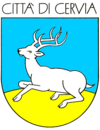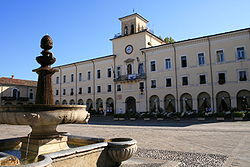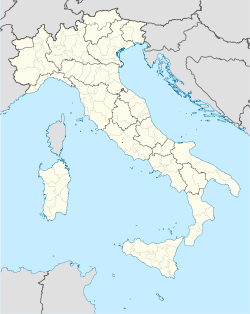- Cervia
-
Cervia — Comune — Comune di Cervia Town Hall. 
Coat of armsLocation of Cervia in Italy Coordinates: 44°15′N 12°22′E / 44.25°N 12.367°ECoordinates: 44°15′N 12°22′E / 44.25°N 12.367°E Country Italy Region Emilia-Romagna Province Province of Ravenna (RA) Frazioni Cannuzzo, Castiglione di Cervia, Milano Marittima, Montaletto, Pinarella, Pisignano, Savio di Cervia, Tagliata, Terme, Villa Inferno Government - Mayor Roberto Zoffoli Area - Total 82 km2 (31.7 sq mi) Elevation 3 m (10 ft) Population (30 June 2008)[1] - Total 28,252 - Density 344.5/km2 (892.3/sq mi) Demonym Cervesi Time zone CET (UTC+1) - Summer (DST) CEST (UTC+2) Postal code 48015, 48016, 48010 Dialing code 0544 Patron saint Saint Paternian Saint day 13 November Website Official website Cervia is a town and comune (municipality) in the province of Ravenna (Emilia-Romagna), central Italy.
Contents
History
Originally called Ficocle, it was probably of Greek origin and was located midway from current Cervia and Ravenna. It is known that this originary settlement was destroyed in 709 by patrician Theodore for its alliance with Ravenna against the loyal Byzantines.
Later the centre was rebuilt in a more secure position, in the Salina. This medieval city grew until it was provided with three fortified entrances, a Palaces of Priors, seven churches and a castle (Rocca) which, according to the legend, was built by Emperor Frederick Barbarossa. The name also changed from Ficocle to Cervia, probably referring to the Acervi, great amounts of salt left in the local evaporation pods. After a long series of events, it became part of the Papal States.
As the time passed, the salt pod turned into a marsh, and on November 9, 1697 Pope Innocent XII ordered it to be rebuilt in a safer location. The new city had huge silos for storage of salt, containing up to 13,000 tons.
Cervia is also mentioned in Dante's Divine Comedy (Inferno, Canto XXVII, lines 40–42).
Nowadays Cervia is a seaside resort on the Adriatic Riviera thanks to its 10 km shore characterised by sandy beaches.
Main sights
- The Cathedral (Santa Maria Assunta), built in 1699–1702.
- The Museum of Salt
- The Communal Palace
- St. Michael Tower
Transportation
Twin towns
 Jelenia Góra, Poland
Jelenia Góra, Poland Mahón, Spain
Mahón, Spain Cluj-Napoca, Romania
Cluj-Napoca, Romania
See also
Notes and references
External links
Emilia-Romagna · Comuni of the Province of Ravenna Alfonsine · Bagnacavallo · Bagnara di Romagna · Brisighella · Casola Valsenio · Castel Bolognese · Cervia · Conselice · Cotignola · Faenza · Fusignano · Lugo · Massa Lombarda · Ravenna · Riolo Terme · Russi · Sant'Agata sul Santerno · SolaroloCategories:- Cities and towns in Emilia-Romagna
- Communes of the Province of Ravenna
- Emilia-Romagna geography stubs
Wikimedia Foundation. 2010.


